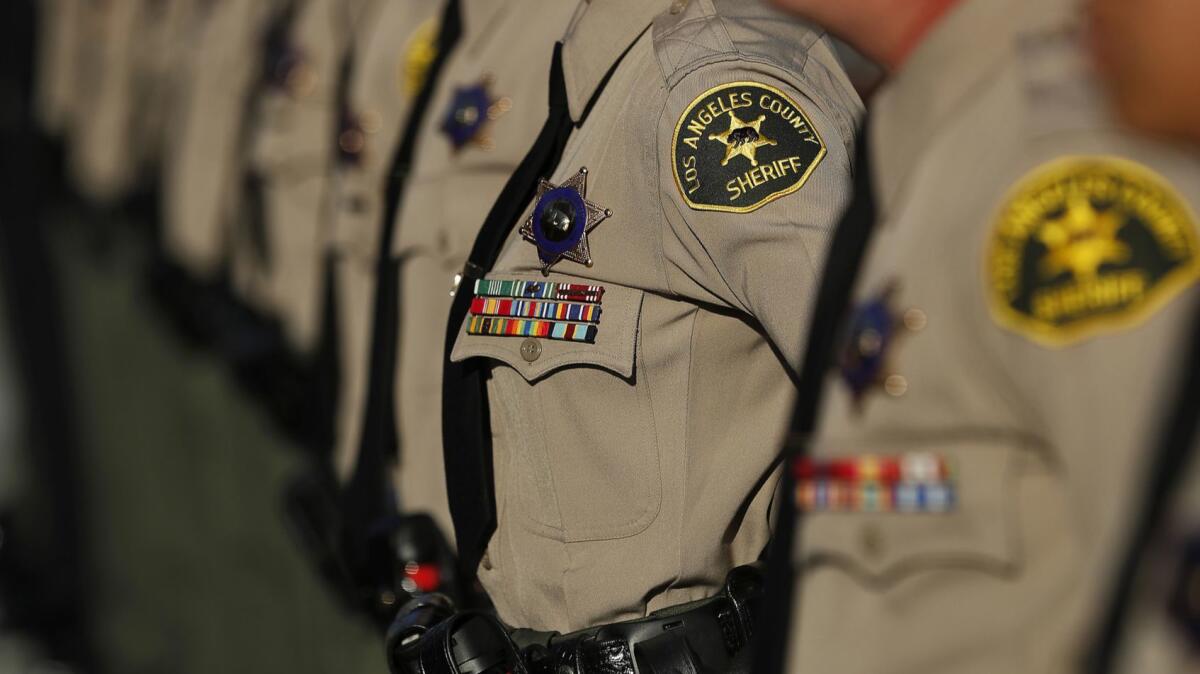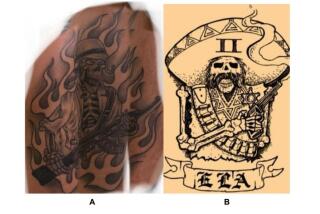A skeleton and a smoking gun: Why a newly elected deputy union board member’s tattoo is sparking concern

- Share via
A union representing Los Angeles County sheriff deputies recently elected to its board of directors a veteran lawman who has a controversial tattoo and was involved in two fatal shootings that cost the county $4 million in legal payouts, sparking concern among oversight officials and justice advocates.
Incoming Assn. of Los Angeles Deputy Sheriffs board member Jason Zabala previously described his tattoo under oath, saying it depicted a skeleton in a cowboy hat with a smoking rifle and the number 140. He called the stark combination of imagery a “station tattoo,” but others described it as the symbol of a deputy gang known as the Regulators.
Zabala has previously denied being part of the group, saying that the number simply meant he was the 140th person to get that same design, and describing the tattoo as a proud mark of camaraderie among fellow deputies. This week he did not respond to a request for comment.
Union president Richard Pippin defended Zabala in an emailed statement Thursday, calling him a “family oriented guy with a big heart” who has dedicated his life to helping others.
Still, advocates — such as James Nelson, campaign and program manager for the community coalition Dignity and Power Now — worried Zabala’s election would not bode well for the department’s efforts to rein in deputy gangs and gang tattoos.
“It’s a bad sign,” Nelson said. “It isn’t the sheriff that runs the department — it’s the unions.”
For decades, the Sheriff’s Department has been plagued by gangs of deputies running roughshod over certain stations and floors of the jail. The groups are known by monikers such as the Executioners, the Vikings and the Regulators, and their members often bear the same sequentially numbered tattoos.
During his swearing-in ceremony nearly a year ago, Sheriff Robert Luna spoke of the need to “eliminate deputy gangs” from the department. Though he created a new office to do that, the department has not yet settled on a policy banning gangs or gang tattoos.
One hurdle to clear before implementing any sweeping new policy is the back-and-forth of the bargaining process with labor leaders, including ALADS.
“We’ve been hearing that the reason we can’t move forward with passing an anti-gang policy — which is the first step in making good on the pledge to get rid of them — is because the sheriff has to negotiate with ALADS,” said Sean Kennedy, who chairs the Civilian Oversight Commission.
“Those sessions are taking much longer than we anticipated,” Kennedy said. “And then, when we hear that he’ll be meeting and conferring with an organization with a tattooed Regulator on the board of directors, it makes everyone believe that we’re engaged in a futile process.”
Pippin disputed that, saying the election outcome “will not change” the organization’s mission and values when it comes to the bargaining process.
“We remain committed to working with the department and the county to achieve the best possible outcomes, not only for our members, but also for members of the communities they serve,” he said.
He did not address the nature or significance of Zabala’s tattoo.
County records show Zabala first started working for the Sheriff’s Department in 2002. Nine years later, he was involved in an on-duty crash that left a woman with spinal injuries. The case settled for $80,000 before trial, according to the news site Knock LA.
Then in 2013, Zabala and his partner stopped a man riding a bicycle and ended up shooting him as he lay face down in his backyard. Prosecutors said the man — Terry Laffitte — had been resisting, so they deemed the shooting lawful. After Laffitte’s family filed suit, the county settled the case for $1.5 million.
The year after that, Zabala was involved in the killing of Johnny Martinez, a 28-year-old man with schizophrenia who was shot 36 times by deputies outside his Vermont Knolls home. Prosecutors also deemed that shooting justified, though in 2018 a civil lawsuit on behalf of the Martinez family ended with a hefty $2.5 million settlement.
It was the 2013 shooting that brought Zabala’s ink to the fore. In connection with the civil lawsuit, Zabala was deposed three times in 2015 and 2016 and asked to describe his tattoo.
Over the course of those depositions he offered additional details about the ink, including that in addition to a smoking gun, the skeleton is holding a “memorial stone” with “CEN” — for Century Station — written on it, along with the Roman numerals XXI. According to Kennedy, those are all key elements of a Regulators’ tattoo.
“The tombstone in the background with the letters for Century Station is some of the main iconography for the Regulators,” he told The Times.
In Zabala’s tattoo, there are also flames along the bottom of the tattoo along with the words “Beati Pacifici,” which he said under oath translates to “Blessed are the Peacemakers.” The entire tattoo is 5 to 6 inches high, on the lower part of his left leg.
At the time, Zabala said in depositions that the Old West style of his tattoo honored the Sheriff’s Department’s founding in 1850 and that skeletons are “an icon of the peace officer.” A Loyola Marymount University report later described Zabala’s ink as “Regulators tattoo #140.”
The district attorney’s office later investigated whether Zabala committed perjury when he described the significance of the number 140 on his tattoo.
Ultimately prosecutors declined to pursue the case, saying it wasn’t clear that Zabala committed perjury. Even if he did lie about his tattoo, they said, it would not have made a difference in the outcome of the case.
“It is unlikely that a false statement about one aspect of one tattoo, among several, would probably influence the outcome of the wrongful death lawsuit,” prosecutors wrote.
When lawyers for the county agreed to settle the lawsuit in 2017, records show they told a Sheriff’s Department investigator that the allegation of perjury was a factor in their decision.
In this year’s union election, Zabala was one of eight candidates for four open seats. He will be sworn in to the seven-member board at Friday morning’s meeting, along with Julian Stern, John Perez and Tony Meraz.
More to Read
Sign up for Essential California
The most important California stories and recommendations in your inbox every morning.
You may occasionally receive promotional content from the Los Angeles Times.











